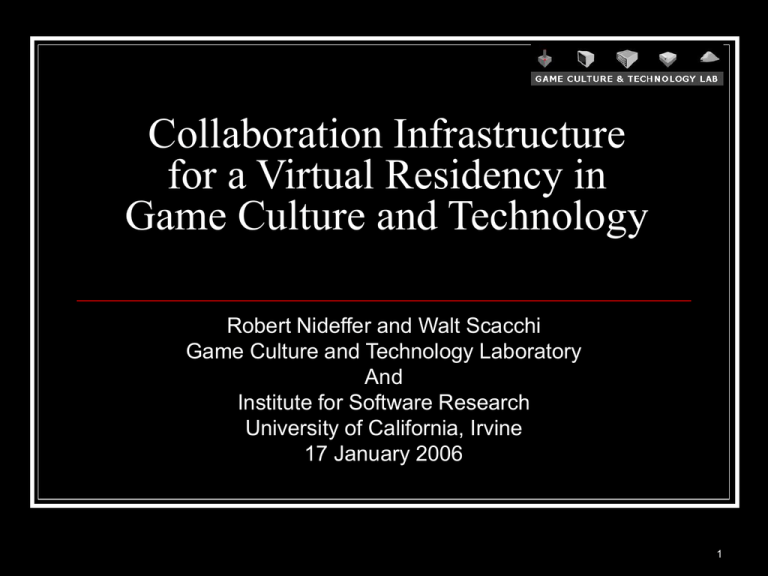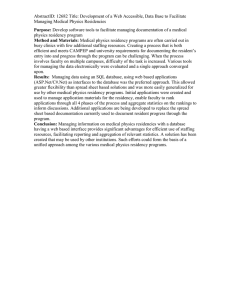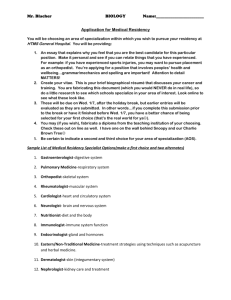Collaboration Infrastructure for a Virtual Residency in Game Culture and Technology
advertisement

Collaboration Infrastructure for a Virtual Residency in Game Culture and Technology Robert Nideffer and Walt Scacchi Game Culture and Technology Laboratory And Institute for Software Research University of California, Irvine 17 January 2006 1 Overview Collaboration in a Virtual Residency What the Collaboration Infrastructure isn’t What the Collaboration Infrastructure is Risks Target outcomes 2 Collaboration in a Virtual Residency Scholars meeting and working together through a persistent online information infrastructure Provide new ways of working together Provide new concepts, techniques, and tools for collective scholarship Confront uncertainties of sustained collaboration with limited face-to-face interaction 3 What the Collaboration Infrastructure isn’t A 3D persistent, immersive virtual world or game world Why? 4 5 6 What the Collaboration Infrastructure isn’t Why? Costs: acquisition, content development, user training, ongoing usage and support Concept: Virtual/game worlds are interesting to study and experience, but lack tools and practical expertise by humanists (and others) Capability: focusing on scholarship versus making a new metaverse or adapting an existing virtual world (and its compromises) 7 What the Collaboration Infrastructure is Activities Capabilities Content/asset types Venues Usage scenarios Stakeholders 8 Activities Reading, viewing, listening Navigational browsing and search Writing Analysis, annotating *Playing Communicating *Tool building Teaching Evaluating Collection building *Modding Mapping 9 Capabilities Collaborative writing (Wiki) Autobiographical writing (Blog) Content update syndication (RSS, Atom) Discussion Forum (BBoard) Email Streaming media Online chat (Instant Messaging) Content management Repository services Database population Content linking Content search (Google/Lucene) Mapping services (Google Maps) Awareness services (Location, Buddy List, Community) Group building Scoring and rewards (Contributions, Rank, Reputation) Journaling and publishing (on/off-line) 10 Content/asset types Text Video Image Audio Maps Annotations *Source code and executables Project space (repository) *Games *Emulators 11 Venues *Game Labs (domestic, international) Conferences (academic research) *Exhibitions Classroom *Companies Events Galleries/Museums *Science Centers Internet/Web Meeting rooms 12 Usage scenarios HRI virtual residency in Spring 06 Conference (“Future of Networked, Multiplayer Games”– April 2006) Workshops (two, April 06, June 06) Regular online meetings (weekly, synchronous) Asset/content creation/modification (ongoing, asynchronous) 13 Stakeholders HRI Principals Game Lab Principals Project software programmer/analysts Virtual residency participants Future virtual residency organizers, participants, system developers, and content maintainers Other external visitors and sponsors 14 Risks Residency participants need to learn new tools and techniques for collaboration Selected technically adept participants Participation is subsidized to provide incentives for learning Insufficient number and technical diversity of participants May need a “community of participants” for virtual residencies to be effective 15 Target outcomes 1 April 06: Version 0.1 Collaboration infrastructure prototype Spring 06: Virtual residency on game culture Summer 06: Collected works from virtual residency (on/off-line book and Web) Summer 06: Version 1.0 Collaboration infrastructure design 16


